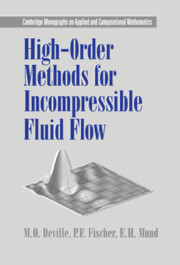Book contents
- Frontmatter
- Contents
- List of Figures
- Preface
- 1 Fluid Mechanics and Computation: An Introduction
- 2 Approximation Methods for Elliptic Problems
- 3 Parabolic and Hyperbolic Problems
- 4 Multidimensional Problems
- 5 Steady Stokes and Navier–Stokes Equations
- 6 Unsteady Stokes and Navier–Stokes Equations
- 7 Domain Decomposition
- 8 Vector and Parallel Implementations
- A Preliminary Mathematical Concepts
- B Orthogonal Polynomials and Discrete Transforms
- Bibliography
- Index
7 - Domain Decomposition
Published online by Cambridge University Press: 24 August 2009
- Frontmatter
- Contents
- List of Figures
- Preface
- 1 Fluid Mechanics and Computation: An Introduction
- 2 Approximation Methods for Elliptic Problems
- 3 Parabolic and Hyperbolic Problems
- 4 Multidimensional Problems
- 5 Steady Stokes and Navier–Stokes Equations
- 6 Unsteady Stokes and Navier–Stokes Equations
- 7 Domain Decomposition
- 8 Vector and Parallel Implementations
- A Preliminary Mathematical Concepts
- B Orthogonal Polynomials and Discrete Transforms
- Bibliography
- Index
Summary
Domain decomposition for numerical solution of PDEs has been an active area of research, with a well-organized international conference series held annually since 1987. The area encompasses preconditioning of linear systems, discretizations, and solution of hybrid systems (e.g., coupled Navier–Stokes and Euler problems). We consider the first two of these in the context of high-order methods.
Introduction
Domain decomposition (dd) alleviates the solution complexity associated with the full problem in a complicated geometry. Broadly, the aim of dd consists in formulating independent problems in separate subdomains whose union constitutes the whole. The decomposition of the domain may be motivated by differing physics within different subdomains, by the availability of fast solvers for each subdomain, by the desire to partition the computational effort across separate processors, or by the inherent heterogeneity of the discretization. We discuss in Section 7.2 preconditioning methods such as substructuring, Schwarz overlapping, and multigrid techniques. Section 7.3 describes the mortar element method, which encompasses both functional and geometrical nonconforming discretizations; suggestions for implementation are given. Section 7.4 reviews the coupling between finite and spectral elements, provides some theoretical considerations about adaptivity near geometrical singularities, and considers for the 2D case hp-spectral triangular elements, which open the way for the coupling between quadrilaterals and triangles.
Preconditioning Methods
Domain-decomposition preconditioning has gained much attention over the past decade, both in theory and in practice.
- Type
- Chapter
- Information
- High-Order Methods for Incompressible Fluid Flow , pp. 333 - 378Publisher: Cambridge University PressPrint publication year: 2002

